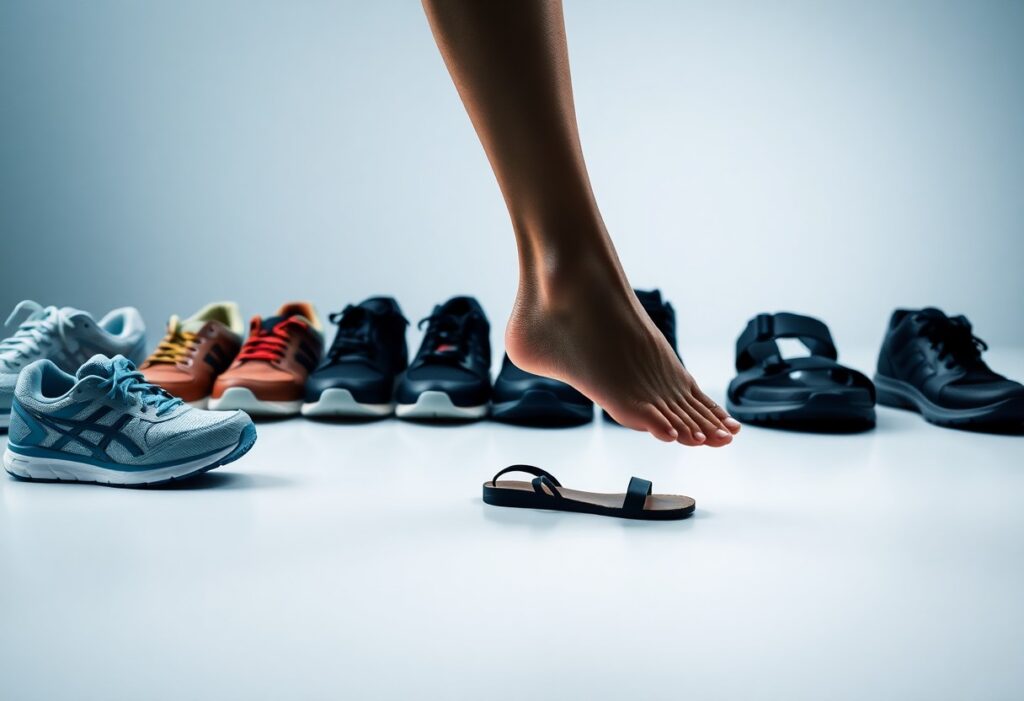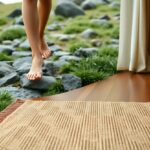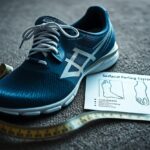
As you walk, the type of footwear you select can either significantly enhance or adversely impact your foot health. Many people mistakenly believe that shoes with more cushioning and support are the best answer to foot discomfort. However, traditional shoes can often exacerbate existing problems rather than alleviate them. Dr. Alissa Kuizinas, a reputable podiatrist from Massachusetts, strongly advocates for barefoot shoes or minimalistic shoes, highlighting that they can contribute to stronger and healthier feet. By choosing footwear that allows your feet to function naturally, you can greatly reduce the chances of developing foot-related issues while promoting overall foot wellness.
Exploring the Hidden Dangers of Conventional Footwear
While traditional shoes may provide temporary relief for foot pain, they frequently exacerbate existing ailments and introduce new complications. Dr. Alissa Kuizinas points out that the $133 billion shoe industry often places more emphasis on aesthetics and profit margins than on genuine foot health. This results in designs that can constrict and weaken your feet over time. This dependency on conventional footwear tends to create a vicious cycle that ultimately undermines your foot health.
Understanding the Shoe Industry's Misguided Focus on Foot Comfort
The root of this issue lies in the shoe industry’s flawed approach to foot health, which often emphasizes adding excessive cushioning, support, and rigid structures to shoes instead of addressing the fundamental causes of discomfort. This misguided strategy may lead to a reliance on shoes that actually compromise your foot health in the long run, resulting in various complications that could otherwise be prevented.
Recognizing the Shortcomings of Traditional Shoe Construction
Traditional shoe designs typically incorporate narrow toe boxes, inflexible soles, and excessive cushioning, all of which can impede natural foot movement, ultimately contributing to weak and dysfunctional feet. Dr. Kuizinas emphasizes that footwear should protect your feet from external hazards rather than limit their natural movements. An ideal shoe design should prioritize natural foot function and embody minimalist characteristics, such as spacious toe boxes, flexible and flat soles, along with minimal cushioning to enhance foot health.
Transitioning to barefoot shoes or minimalistic footwear allows you to actively strengthen your feet and significantly improve your overall foot well-being. Dr. Kuizinas promotes the philosophy of using as little shoe as possible, which encourages your feet to function naturally and move without restrictions. This is essential for maintaining healthy foot mechanics and overall strength.
The Vital Importance of Allowing Natural Foot Movement
Wearing footwear that restricts your foot's ability to move freely can result in a multitude of foot problems and discomfort. It is crucial to assess how your shoe choices affect your overall foot health and levels of comfort.
Evaluating the Impact of Footwear on Mobility and Flexibility
To fully understand how shoes affect your foot's ability to move, it’s important to analyze the specific designs and features of your chosen footwear. Traditional shoes often come with cushioning and support elements that can inadvertently restrict your foot's natural movements, leading to weak and dysfunctional feet over time. This restriction may hinder your feet from developing the necessary strength and flexibility they need to function optimally.
Unlocking the Benefits of Unrestricted Foot Mobility
The benefits of allowing your feet to move naturally are extensive, as strong feet form the foundation of overall foot health. By selecting minimalistic shoes or barefoot footwear, you enable your feet to operate as intended, promoting strength and resilience.
Movement is fundamental for developing strong feet. When restricted by conventional footwear, you risk encountering various foot issues and discomfort. In contrast, adopting minimalistic shoes or barefoot alternatives can greatly enhance your foot health by permitting natural movement and facilitating strength-building. By consciously selecting the right footwear, you can reduce your risk of developing foot problems and improve your overall foot wellness.
Diving Deep into the Concept of Functional Footwear
Acquiring a comprehensive understanding of functional footwear is essential, as these shoes emphasize both foot health and natural movement. Functional shoes are specifically crafted to allow your feet to perform as intended, eliminating the need for excessive support or confinement.
Defining Functional Shoes: Key Features and Benefits
Upon researching and trying various shoe styles, you'll find that functional footwear is characterized by unique attributes, such as a wide toe box, flat and flexible soles, with minimal cushioning and support. These features empower your feet to move freely and naturally, fostering stronger and more capable foot mechanics.
The Health Benefits of Wearing Functional Shoes
Donning functional shoes yields numerous advantages, including enhanced foot strength, a reduced risk of injury, and improved overall foot health. These shoes facilitate your feet to function as they were designed, paving the way for stronger feet and better balance in your everyday activities.
Functionally designed footwear aims to support your feet while avoiding unnecessary restrictions, allowing them to move and flex naturally. This design philosophy promotes optimal foot health and minimizes the likelihood of developing foot ailments. By opting for functional shoes like barefoot shoes or minimalistic options, you proactively encourage healthy foot function and reduce the risk of foot pain and injury. Transitioning to functional footwear may require patience and gradual adaptation, but the long-term rewards for your foot health are invaluable.
Recognizing the Essential Features of Effective Footwear
To achieve optimal foot health, it is vital to look for shoes equipped with specific features. The key attributes to consider include:
- Wide toe box
- Flat and flexible soles
- Minimal cushioning and support
Being aware of these characteristics will significantly assist you in selecting shoes that promote healthy foot function and support.
The Importance of Wide Toe Boxes and Flexible Soles
A crucial feature of functional shoes is a wide toe box, which allows your toes to spread naturally. This design helps to prevent toe jamming and other discomfort-related issues that could lead to chronic foot pain.
Understanding the Necessity for Minimal Cushioning and Support
In addition to a wide toe box, functional shoes should also incorporate minimal cushioning and support. This design element enables your feet to move naturally while fortifying foot muscles, consequently diminishing the risk of foot issues.
It is essential to emphasize that minimalistic footwear, which includes barefoot shoes, can significantly enhance your foot health by allowing your feet to function freely. By choosing shoes with minimal cushioning and support, you can strengthen the muscles in your feet and lower the risk of injuries. This strategic choice not only improves your overall foot health but also reduces the chances of experiencing chronic pain. Therefore, it’s imperative to prioritize footwear that enables your feet to move naturally without excessive cushioning or support.
Successfully Transitioning to Functional Footwear
Having acknowledged the significance of functional footwear, it’s time to begin your transition. Contrary to the common misconception that more cushioning and support equate to better comfort, you should opt for minimalistic shoes or barefoot shoes that enhance your feet's natural functioning.
Practical Steps to Ease into Functional Footwear
Despite any initial hesitations, start incorporating functional shoes into your daily routine with the following practical tips:
- Begin with short walks and gradually increase the distance
- Select shoes that feature a wide toe box and flat soles
- Choose minimal cushioning and support
The key is to give your feet time to adapt to the new footwear while building the muscles in your feet.
The Importance of Patience During the Transition
Transitioning to functional footwear requires patience and a gradual approach. Shoes that are overly minimalist may cause discomfort and pain if your feet are not accustomed to them. Taking a slow and steady approach is crucial, allowing your feet to acclimate to the new footwear.
Footwear choices like barefoot shoes or minimalistic shoes can provide immense benefits for your foot health, but it’s essential to introduce them gradually. Overuse or improper sizing can lead to injuries or prolonged discomfort. The ultimate goal is to bolster your foot muscles while enhancing your overall foot health, so exercise patience and avoid hurrying through the process. The benefits will be significant; anticipate improvements in balance, reduced pain, and stronger feet.
Building Strong and Functional Feet for Better Health
Even in a world dominated by shoes that prioritize excessive cushioning and support, you can cultivate strong and functional feet by making informed footwear choices.
The Connection Between Foot Strength and Overall Wellness
Alongside various health factors, foot strength plays a vital role in your overall well-being, influencing your balance, posture, and movement capabilities.
The Role of Functional Footwear in Strengthening Feet
Functionally designed shoes that feature a wide toe box, flat and flexible soles, and minimal cushioning are crucial for developing strong feet, as they promote natural movement.
Indeed, wearing functional shoes or barefoot shoes can greatly assist in building stronger foot muscles and enhancing your overall foot health. By allowing your feet the freedom to move and function naturally, you can minimize the risk of foot problems and optimize your balance and stability. As you transition to minimalistic shoes, you should expect to notice improvements in your walking technique and an overall sense of well-being.
By taking proactive steps towards your foot health, you can choose shoes that enhance your feet's natural functions rather than impede them. Opting for barefoot shoes or minimalistic options that allow your feet to operate freely will promote strength development over time. In doing so, you’ll experience increased stability and comfort in your activities, giving your feet the chance to grow strong and capable. Start your journey by seeking footwear with a wide toe box, flat and flexible soles, and minimal cushioning and support, and remember to be patient as you transition to a more natural walking style.
The Article A Podiatrist’s Guide to How Shoes Affect Your Foot Health appeared first on My Shoes Finder
The Article How Shoes Impact Your Foot Health: A Podiatrist’s Insights Was Found On https://limitsofstrategy.com





